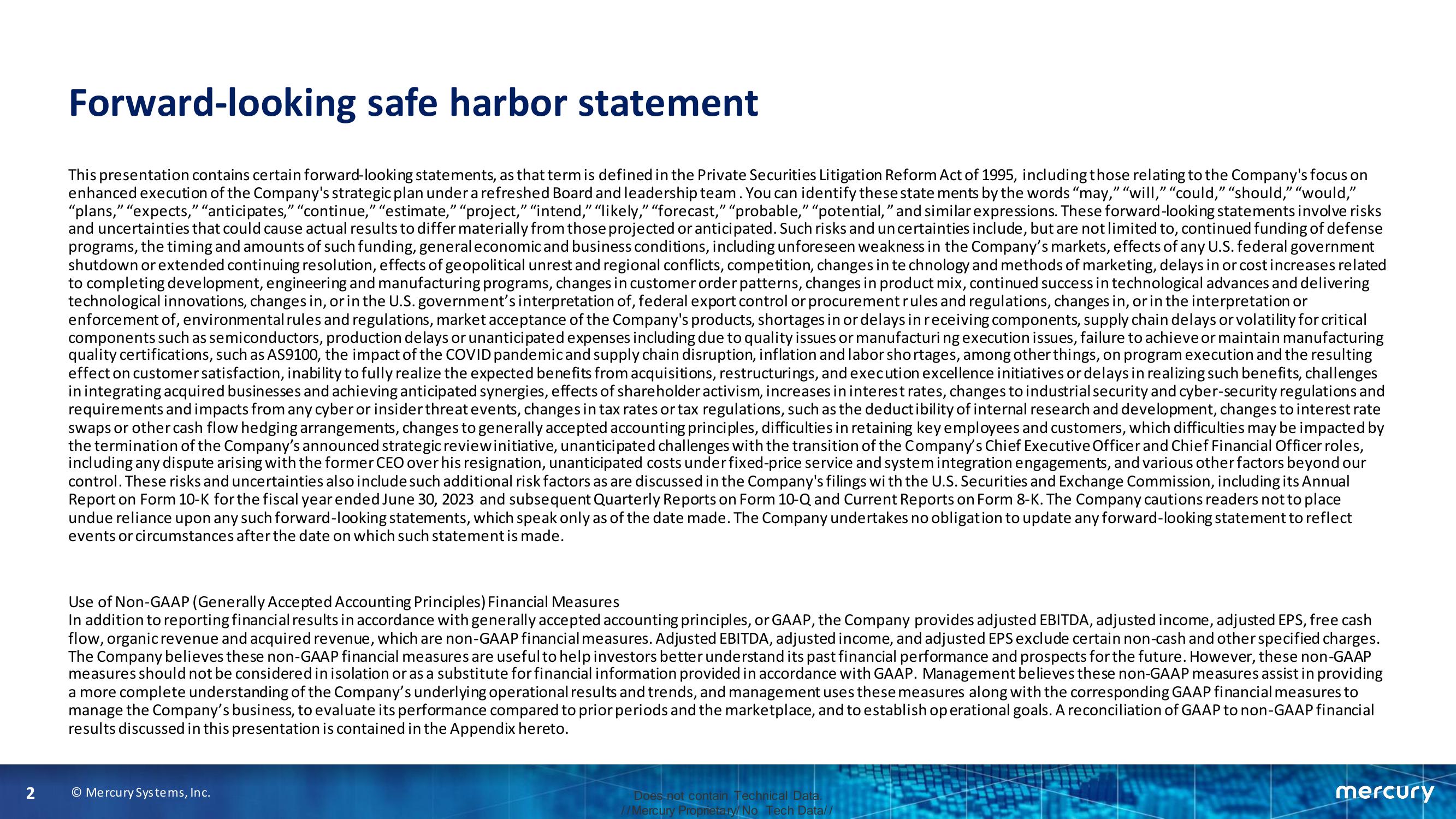Fourth Quarter and Fiscal Year 2023 Financial Results
2
Forward-looking safe harbor statement
This presentation contains certain forward-looking statements, as that term is defined in the Private Securities Litigation Reform Act of 1995, including those relating to the Company's focus on
enhanced execution of the Company's strategic plan under a refreshed Board and leadership team. You can identify these statements by the words "may," "will," "could," "should," "would,"
"plans," "expects," "anticipates," "continue," "estimate," "project," "intend," "likely," "forecast," "probable," "potential," and similar expressions. These forward-looking statements involve risks
and uncertainties that could cause actual results to differ materially from those projected or anticipated. Such risks and un certainties include, but are not limited to, continued funding of defense
programs, the timing and amounts of such funding, general economic and business conditions, including unforeseen weakness in the Company's markets, effects of any U.S. federal government
shutdown or extended continuing resolution, effects of geopolitical unrest and regional conflicts, competition, changes in technology and methods of marketing, delays in or cost increases related
to completing development, engineering and manufacturing programs, changes in customer order patterns, changes in product mix, continued success in technological advances and delivering
technological innovations, changes in, or in the U.S. government's interpretation of, federal export control or procurement rules and regulations, changes in, or in the interpretation or
enforcement of, environmental rules and regulations, market acceptance of the Company's products, shortages in or delays in receiving components, supply chain delays or volatility for critical
components such as semiconductors, production delays or unanticipated expenses including due to quality issues or manufacturi ng execution issues, failure to achieve or maintain manufacturing
quality certifications, such as AS9100, the impact of the COVID pandemic and supply chain disruption, inflation and labor shortages, among other things, on program execution and the resulting
effect on customer satisfaction, inability to fully realize the expected benefits from acquisitions, restructurings, and execution excellence initiatives or delays in realizing such benefits, challenges
in integrating acquired businesses and achieving anticipated synergies, effects of shareholder activism, increases in interest rates, changes to industrial security and cyber-security regulations and
requirements and impacts from any cyber or insider threat events, changes in tax rates or tax regulations, such as the deductibility of internal research and development, changes to interest rate
swaps or other cash flow hedging arrangements, changes to generally accepted accounting principles, difficulties in retaining key employees and customers, which difficulties may be impacted by
the termination of the Company's announced strategic review initiative, unanticipated challenges with the transition of the Company's Chief Executive Officer and Chief Financial Officer roles,
including any dispute arising with the former CEO over his resignation, unanticipated costs under fixed-price service and system integration engagements, and various other factors beyond our
control. These risks and uncertainties also include such additional risk factors as are discussed in the Company's filings with the U.S. Securities and Exchange Commission, including its Annual
Report on Form 10-K for the fiscal year ended June 30, 2023 and subsequent Quarterly Reports on Form 10-Q and Current Reports on Form 8-K. The Company cautions readers not to place
undue reliance upon any such forward-looking statements, which speak only as of the date made. The Company undertakes no obligation to update any forward-looking statement to reflect
events or circumstances after the date on which such statement is made.
Use of Non-GAAP (Generally Accepted Accounting Principles) Financial Measures
In addition to reporting financial results in accordance with generally accepted accounting principles, or GAAP, the Company provides adjusted EBITDA, adjusted income, adjusted EPS, free cash
flow, organic revenue and acquired revenue, which are non-GAAP financial measures. Adjusted EBITDA, adjusted income, and adjusted EPS exclude certain non-cash and other specified charges.
The Company believes these non-GAAP financial measures are useful to help investors better understand its past financial performance and prospects for the future. However, these non-GAAP
measures should not be considered in isolation or as a substitute for financial information provided in accordance with GAAP. Management believes these non-GAAP measures assist in providing
a more complete understanding of the Company's underlying operational results and trends, and management uses these measures along with the corresponding GAAP financial measures to
manage the Company's business, to evaluate its performance compared to prior periods and the marketplace, and to establish operational goals. A reconciliation of GAAP to non-GAAP financial
results discussed in this presentation is contained in the Appendix hereto.
© Mercury Systems, Inc.
Does not contain Technical Data.
//Mercury Proprietary/No Tech Data//
mercuryView entire presentation